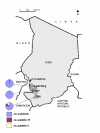Insecticide resistance in Anopheles gambiae from south-western Chad, Central Africa
- PMID: 18823537
- PMCID: PMC2566574
- DOI: 10.1186/1475-2875-7-192
Insecticide resistance in Anopheles gambiae from south-western Chad, Central Africa
Abstract
Background: Indoor residual spraying and insecticide-treated nets (ITN) are essential components of malaria vector control in Africa. Pyrethroids are the only recommended compounds for nets treatment because they are fast-acting insecticides with low mammalian toxicity. However, there is growing concern that pyrethroid resistance may threaten the sustainability of ITN scaling-up programmes. Here, insecticide susceptibility was investigated in Anopheles gambiae sensu lato from an area of large scale ITN distribution programme in south-western Chad.
Methods: Susceptibility to 4% DDT, 0.05% deltamethrin, 0.75% permethrin, 0.1% bendiocarb and 5% malathion was assessed using the WHO standard procedures for adult mosquitoes. Tests were carried out with two to four days-old, non-engorged female mosquitoes. The An. gambiae Kisumu strain was used as a reference. Knockdown effect was recorded every 5 min and mortality scored 24 h after exposure. Mosquitoes were identified to species and molecular form by PCR-RFLP and genotypes at the kdr locus were determined in surviving specimens by Hot Oligonucleotide Ligation Assay (HOLA).
Results: During this survey, full susceptibility to malathion was recorded in all samples. Reduced susceptibility to bendiocarb (mortality rate of 96.1%) was found in one sample out of nine assayed. Increased tolerance to pyrethroids was detected in most samples (8/9) with mortality rates ranging from 70.2 to 96.6% for deltamethrin and from 26.7 to 96.3% for permethrin. Pyrethroid tolerance was not associated with a significant increase of knock-down times. Anopheles arabiensis was the predominant species of the An. gambiae complex in the study area, representing 75 to 100% of the samples. Screening for kdr mutations detected the L1014F mutation in 88.6% (N = 35) of surviving An. gambiae sensu stricto S form mosquitoes. All surviving An. arabiensis (N = 49) and M form An. gambiae s.s. (N = 1) carried the susceptible allele.
Conclusion: This first investigation of malaria vector susceptibility to insecticides in Chad revealed variable levels of resistance to pyrethroid insecticides (permethrin and deltamethrin) in most An. gambiae s.l. populations. Resistance was associated with the L1014F kdr mutation in the S form of An. gambiae s.s.. Alternative mechanisms, probably of metabolic origin are involved in An. arabiensis. These results emphasize the crucial need for insecticide resistance monitoring and in-depth investigation of resistance mechanisms in malaria vectors in Chad. The impact of reduced susceptibility to pyrethroids on ITN efficacy should be further assessed.
Figures
References
-
- WHO . Scaling-up insecticide treated netting programmes in Africa: a strategic framework for coordinated national action. WHO/CDS/RBM/2002.43, Geneva, World Health Organization; 2005.
-
- Gillies MT, De Meillon B. The Anophelinae of Africa South of the Sahara (Ethiopian Zoogeographical Region) Publication of the South Africa Institute of Medical Research. 1968;54:203–207.
Publication types
MeSH terms
Substances
LinkOut - more resources
Full Text Sources
Miscellaneous


